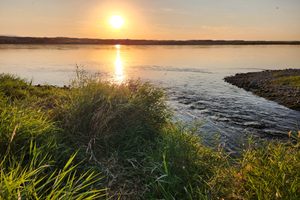
The Hanford Reach, bordering the Hanford Site to the north and east, is by far the longest free-flowing stretch of the Columbia River in the United States. When the Hanford Site was built during World War II, the only dams downstream from Grand Coulee Dam were Bonneville and Rock Island, both completed in 1938. Since then, eight more dams have been built on the main stem of the Columbia, the last being John Day in 1971.
Dams have had a devastating impact on the salmon runs, even with ameliorating features such as fish ladders. Not only do salmon have difficulty navigating the slack water in the reservoir, but their spawning areas have been drowned. The result is that some 80 percent of the remaining salmon run now spawns in the reach. Other riparian species have also found the reach a refuge.
Nonetheless, the would-be dam builders in the Army Corps of Engineers persisted in their efforts to dam the reach too. The major justification was barge travel, although hydropower was also a consideration. Barges can travel up the Columbia (and its tributary the Snake, which enters the Columbia below the reach) all the way to Lewiston, Idaho, because the dams on that route are all equipped with locks. They proposed making barge travel possible all the way to Wenatchee on the Columbia, some 60-odd miles above the Priest Rapids Dam at the upper end of the reach. This would have required retrofitting locks onto the dams between Wenatchee and the reach, and building a new dam to flood the reach for barge traffic. This dam, to be named Ben Franklin, was proposed in the 1960s and again in the 1980s, but was ultimately blocked because it would have flooded radiologically contaminated areas. Undaunted, in the late 1980s the Corps instead proposed dredging a channel through the reach for the barges. This would have been equally devastating for the spawning grounds, and was also blocked.
With the end of the Cold War and the decommissioning of the Hanford reactors, national security was now not so much a consideration in allowing more public access to the area, but the radiological hazards were still present. Agitation to designate the reach as a wild and scenic river ran from the mid-80s through the 90s. Finally, the buffer areas around the Hanford site (but not the old Hanford site itself) were declared as the Hanford Reach National Monument by President Bill Clinton in 2000.

Post a Comment